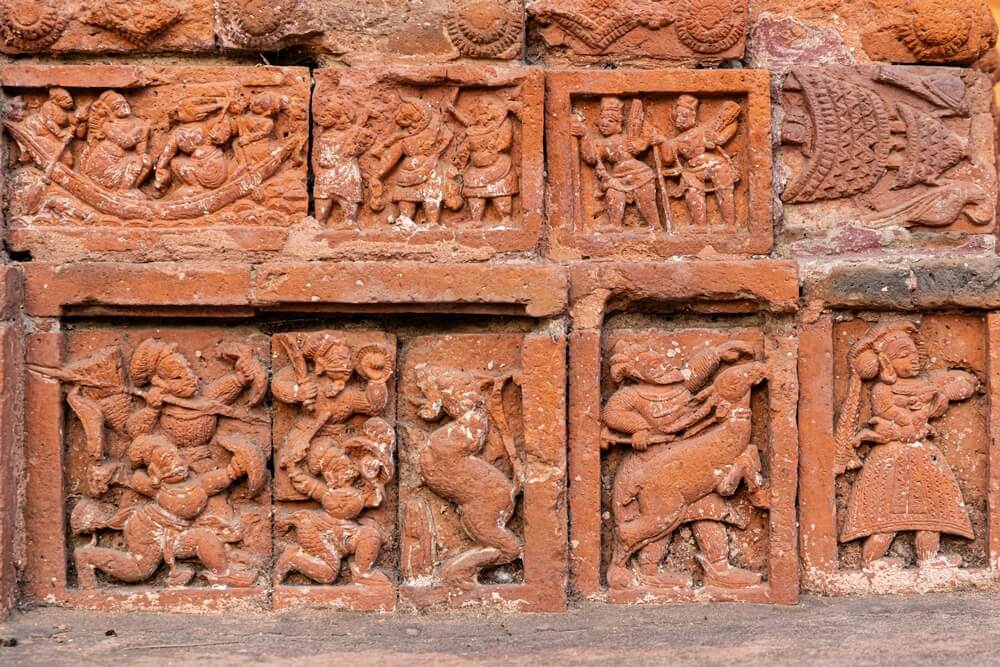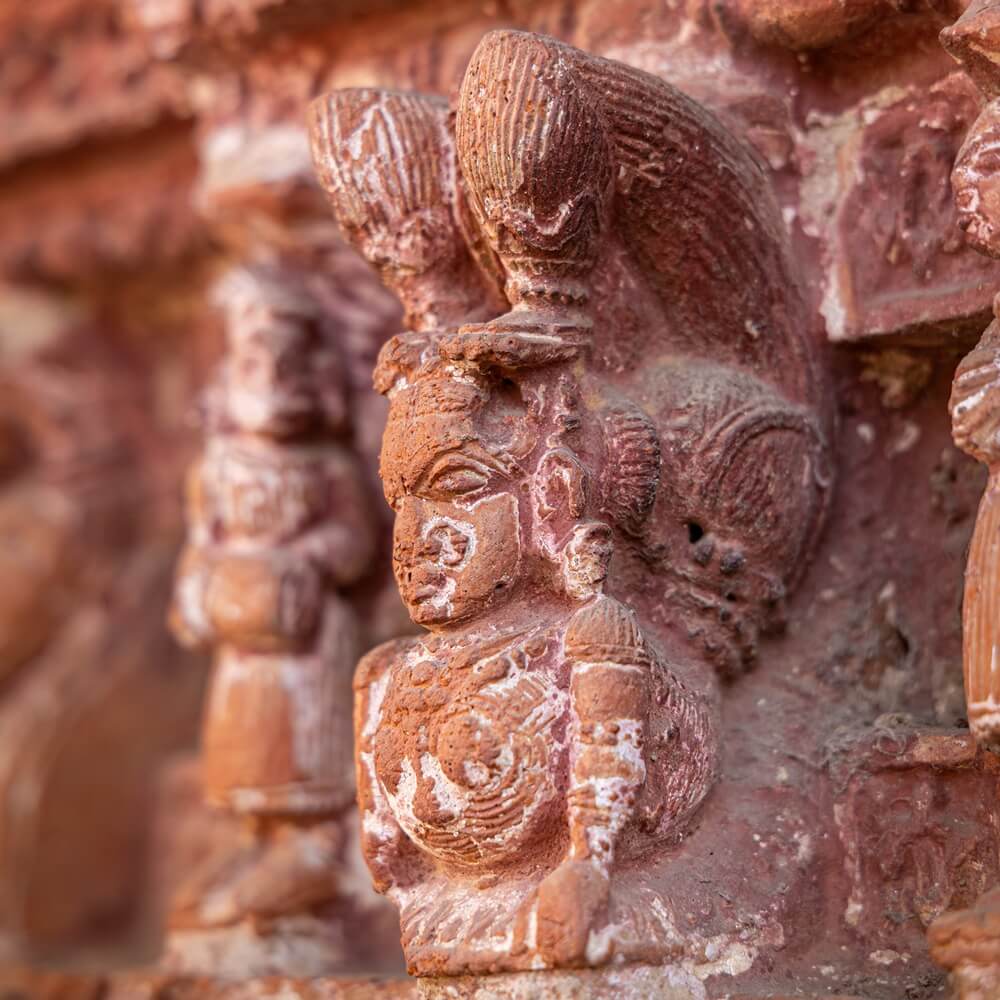
Nestled amidst the lush landscapes of West Bengal, Guptipara (75km north of Kolkata) stands as a testament to the rich tapestry of culture and heritage that defines this region. This quaint and charming village, with its roots dating back several centuries, offers a captivating glimpse into the history and traditions of West Bengal. Guptipara’s name itself, which means “hidden neighborhood” in Bengali, hints at the intriguing stories and hidden treasures that lie within its boundaries.

Guptipara is a great place for Bengal sweet lovers. The most famous of these is the Gupo Sandesh (made of channa extracted from cow’s milk), considered by many to be Bangal’s first branded sweet.
Guptipara is the birthplace of sweet maker Bhola Moira, who was famous not for sweet making skills but for his Kabi gaan (folk songs).

Guptipara is also the home of Bengal’s first “Barowari” (publicly organized) Durga Puja. In the 1760s, a group of men were stopped from taking part in the household Durga Puja of the ruling Sen family in Guptipara.
In retaliation, seven of these men formed a committee and organised their own “Barowari Puja.” (In Sanskrit Bar means ‘public’ or ‘community’, and in Farsi wari means ‘by’ or ‘for’).
The concept of community Durga Puja was later brought to Kolkata in 1832.

Guptipara was also once known as a secret place of Tantra practice. This is known from the researched genealogy of Chattashovakar clan.
It is said that there was a Dasamahavidya temple in ancient times at Guptipara which no longer exists. Some say the nearby Deshkali Mata temple stands on the site of this much earlier structure.
Guptipara also had special fame as a seat of study in the Sanskrit language, the village gave birth to many famous scholars of Nyayashastra and Smritishastra.
But today the primary attraction of Guptipara are its temples, located a short walk east from the village. Arranged in a quadrangle and enclosed within a high wall, the entire complex is collectively known as Brindavan Chandra Math, and consists of four temples dedicated to Chaitanyadev (Chaitanya-Nityananda), Brindavan Chandra (Radha-Krishna and Jagannath), Ramchandra (Rama, Sita, Lakshmana and Hanuman) and Krishnachandra (Radha-Krishna).
Ramchandra Temple

The west-facing Ekratna Ramachandra Temple was constructed by King Harishchandra Roy of Sheoraphuli in Hooghly during the reign of Sadananda Roy Dandiswami (1822-29 CE). With an octagonal shikhara resting on charchala roof, the west and south-facing elevations are adorned with fantastic rich and intricate terracotta.






Scenes from Ramayana, royal processions (including courtly figures reclining on cushions carried in palanquins), long river boats with makara prows propelled by men with oars, Shiva riding with Parvati on a bull, unusual scenes of men fighting lions (some bare-handed!), european soldiers with guns at sea and on land, warriors on elephants, horses, and fantastic lions, hunting scenes, images from Krishnalila and Rasachakra, various avatars and forms of Durga, etc.



The list of imagery here is almost limitless. I actually visited this temple twice during my stay in Guptipara; once in the early morning and again in the late afternoon, in an attempt to capture it as best I could. On both occasions I had the entire temple complex to myself, and the rural setting just contributed even more to the overall experience.






Although the more decorative terracotta adorns the west-facing temple entrance, it is well worth skirting to the south to see the other decorated elevation. This is still extremely elaborate, including some wonderful stone fake doors, and the equally exquisite terracotta high up on the single octagonal shikhara.




I spoke to a local here who claimed the temple was almost 100 years older than widely thought. The story goes that during the reign of Alivardi Khan, Nawab of Bengal from 1740 to 1756, it was brought to his attention that tax had not paid for a very long period of time for a plot of land in the name of Brindavan Chandra.





He had no idea that Brindavan Chandra was an idol, so he ordered Brindavan Chandra to be brought to his court for trial. The devotees of Brindavan Chandra made a replica of the deity and took it to court. Alivardi Khan was so surprised to see the deity, he cancelled all the outstanding taxes due. He also gave permission to build the temple of Brindavan Chandra that we now see today.
Shri Ram, Lakshman, Sita Devi and Hanuman are the presiding deities in the sanctum sanctorum of the temple.
Brindavan Chandra Temple

With a footprint of 13.2m x 12m, the south-facing 18m high Brindavan Chandra Temple dominates the complex. It is widely thought this atchala temple was built around 1810 CE under the patronage of Zamindar Ganga Narayan Sarkar of Bagbazar, possibly assisted by King Vishveshwar Roy who donated several lands and properties in the name of the temple in Somara region, which is adjacent to Guptipara.
There is little terracotta work on the facade of the temple, but the real joy of this temple, and an unexpected one, lies within the temple interior.




The inner verandah and sanctum of the temple are richly adorned with fresco paintings, both on the walls and ceiling. Various mythological stories are told, accompanied with vibrant flower and vine motifs. Of the 150 temples I visited during my tour of West Bengal, the paintings here far surpassed anything else I had seen.






In the sanctum of the temple is the dark blue Shri Brindavana Chandra, next to a golden Shri Radhika. Right behind them are the trinity of Jagannath, Balabhadra and Subhadra. On the day of the Rath Jatra these three idols are carried out by the towering rath (a chariot, known as ulto rath) to another temple (Masir Bari) where they are kept for 7 days, afterwhich the journey is retraced back to the Brindavan Chandra Temple.

It is said that Satyananda Saraswati, a monk of Dashanami sect, brought the idol of Brindavan Chandra from Shantipur and established it in Guptipara during the times of Mughal rule in Bengal. It’s quite possible that this idol is the sole survivor of an earlier temple that once resided where
Brindavan Chandra now stands.
Chaitanya Temple

Measuring 6.7m x 7m, the Chaitanya temple is the smallest of the four temples in the complex, and is somewhat overshadowed by its larger counterparts. However, in many respects this is architecturally the most significant temple here, as it is widely believed to be the earliest Bangla-style temple still standing.


David McCutchion attributes a construction date of the late 16th to early 17th century, contemporary with the reign of Akbar (1542 – 1605 CE). Although almost all the terracotta work has now been lost, he observed that what remains is comparable with the ornamentation of the late 16th century Jora Deul temple in Baidyapur.
The sanctum houses idols of idol of Gouranga (Chaitanya Mahaprabhu) & Nityananda.
Krishna Chandra Temple

Constructed in 1745 CE during the rule of Nawab Alivardi Khan, the east-facing Krishna Chandra atchala temple was probably once more extensively covered with terracotta work, but now only a small amount survives around the triple-arched entrance.

Shri Krishnachandra and Shri Radhika are currently presiding in the sanctum sanctorum.



Gateway
On the southern side of the courtyard opposite the Brindavan Chandra Temple stands a gateway, the main entrance into the temple complex. Although significantly renovated, it still retains much of the terracotta ornamentation.

Sen Bari
A short distance from Brindavan Chandra Math on the road leading back to the village is a huge mansion. This is Sen Bari, established by descendants of Kirti Chandra Sen, the zamindars of Guptipara.

Guptipara serves as a living testament to the enduring cultural heritage of West Bengal, offering an experience that is as enchanting as it is enriching. So, whether you’re a history enthusiast, an art lover, a foodie with a sweet tooth, or simply an explorer at heart, a visit to Guptipara promises an unforgettable encounter with the past and an appreciation of the present.
Please ‘Like’ or add a comment if you enjoyed this blog post. If you’d like to be notified of any new content, just sign up by clicking the ‘Follow’ button. If you have enjoyed this or any other of my posts, please consider buying me a coffee. There’s a facility to do so on the righthand side of this website for desktop users, and just above the comment section for mobile users. Thank you !
If you’re interested in using any of my photography or articles please get in touch. I’m also available for any freelance work worldwide, my duffel bag is always packed ready to go…
KevinStandage1@gmail.com
kevinstandagephotography.wordpress.com

















Beautiful photos. Thank you for this blog. Please keep up the great work that you are doing. God Bless. Madhvi
LikeLiked by 1 person
Thank you !
LikeLike
You missed the oldest residence of the Sen family, established by Kirti Chandra Sen. It is where the Durga Puja is held every year— for the past 430 years. It’s older than the Brindaban Chandra Temples.
LikeLiked by 1 person